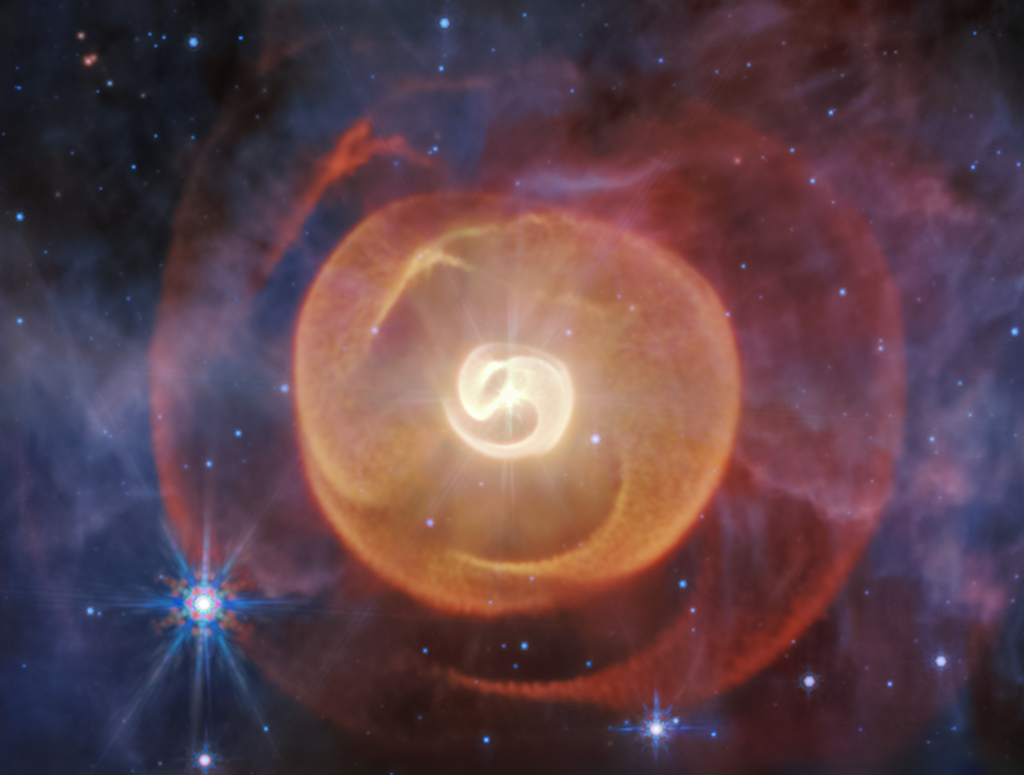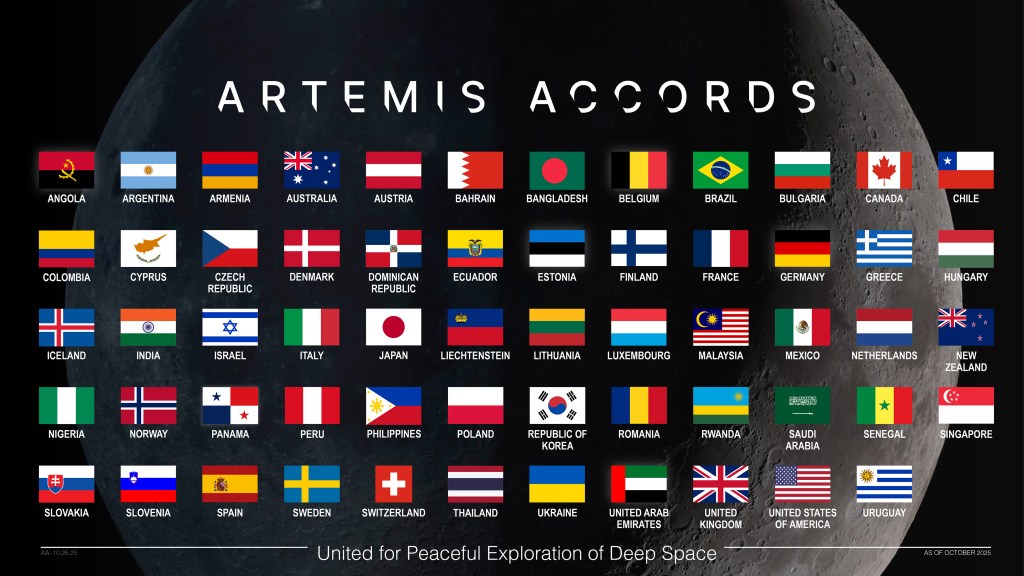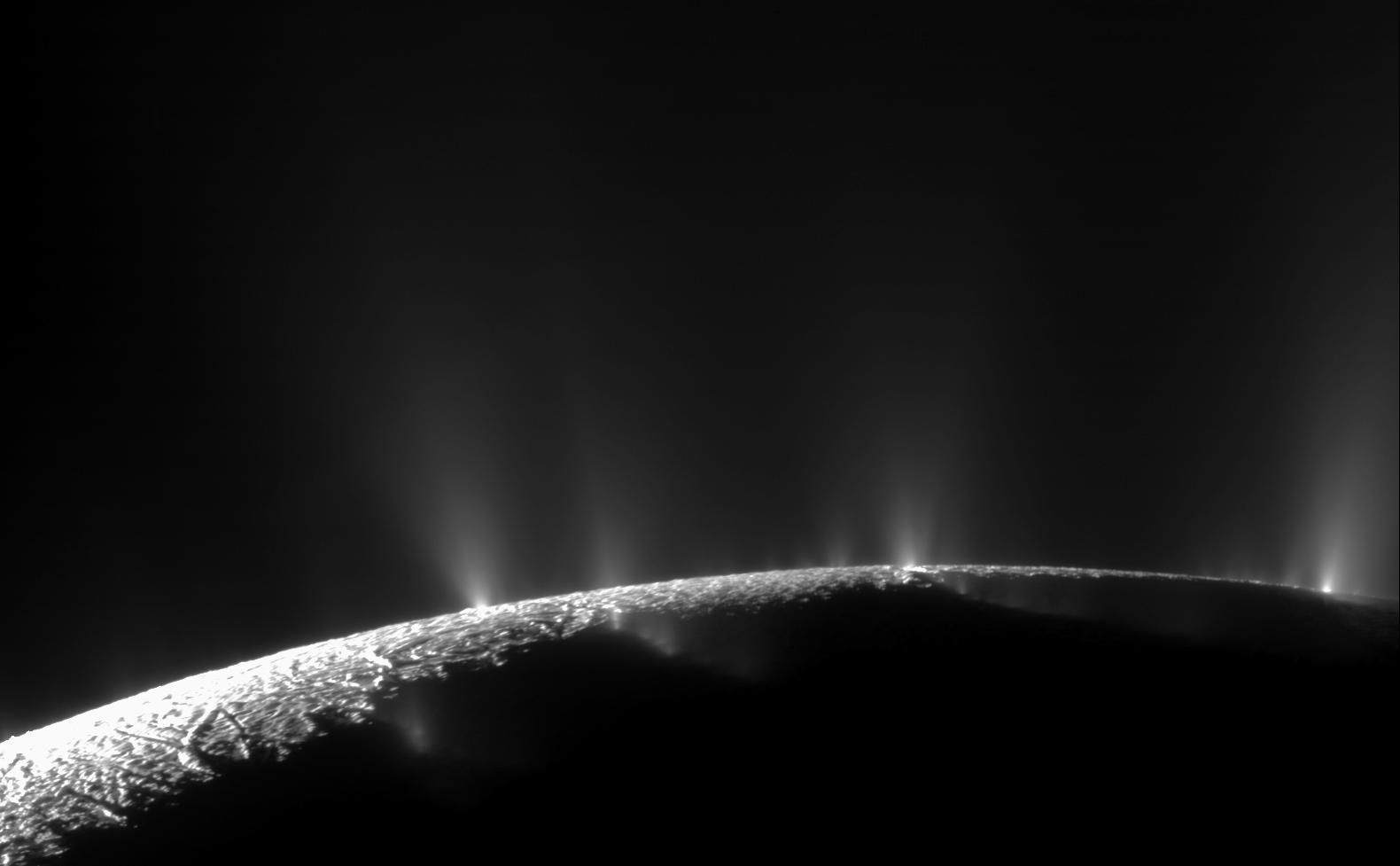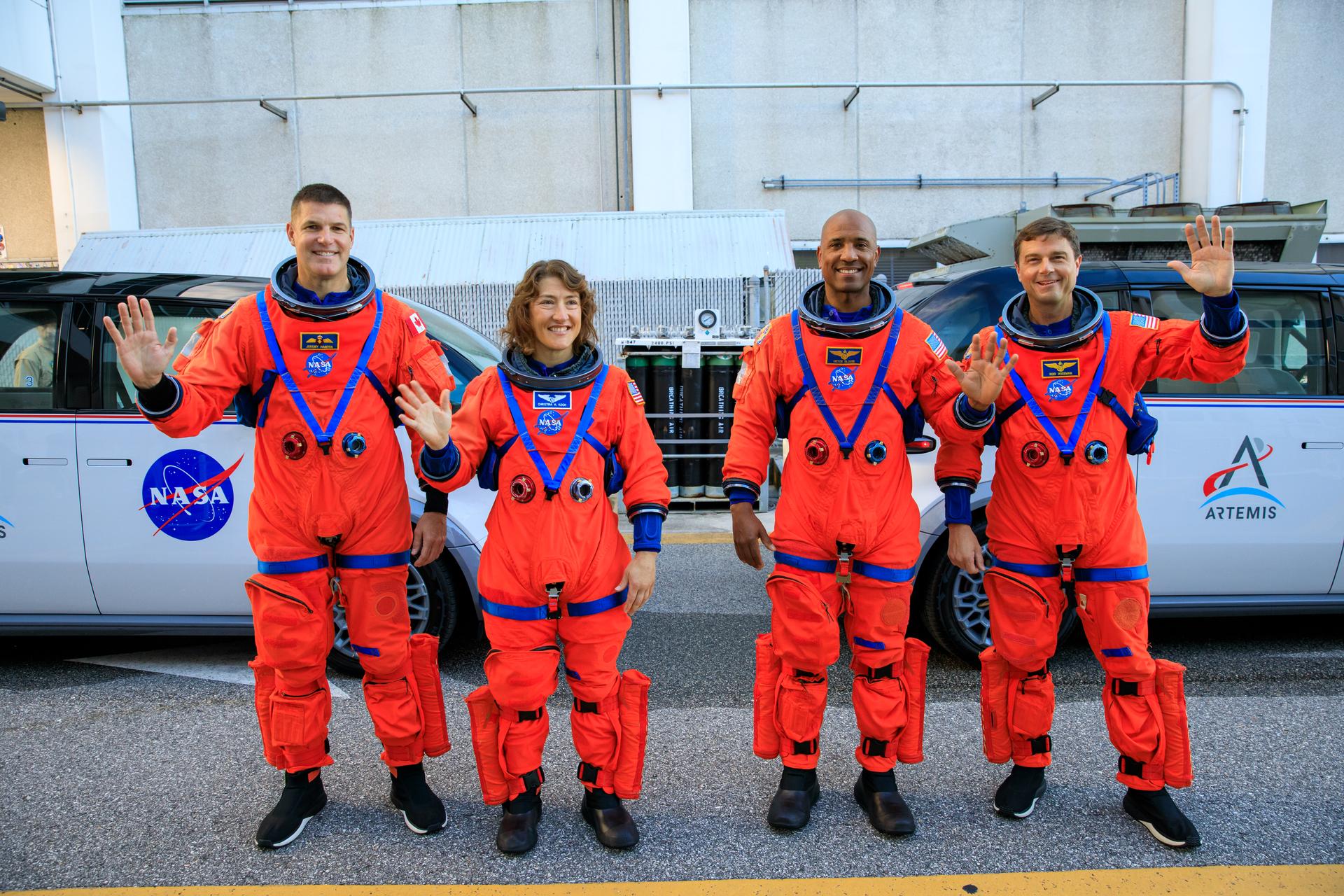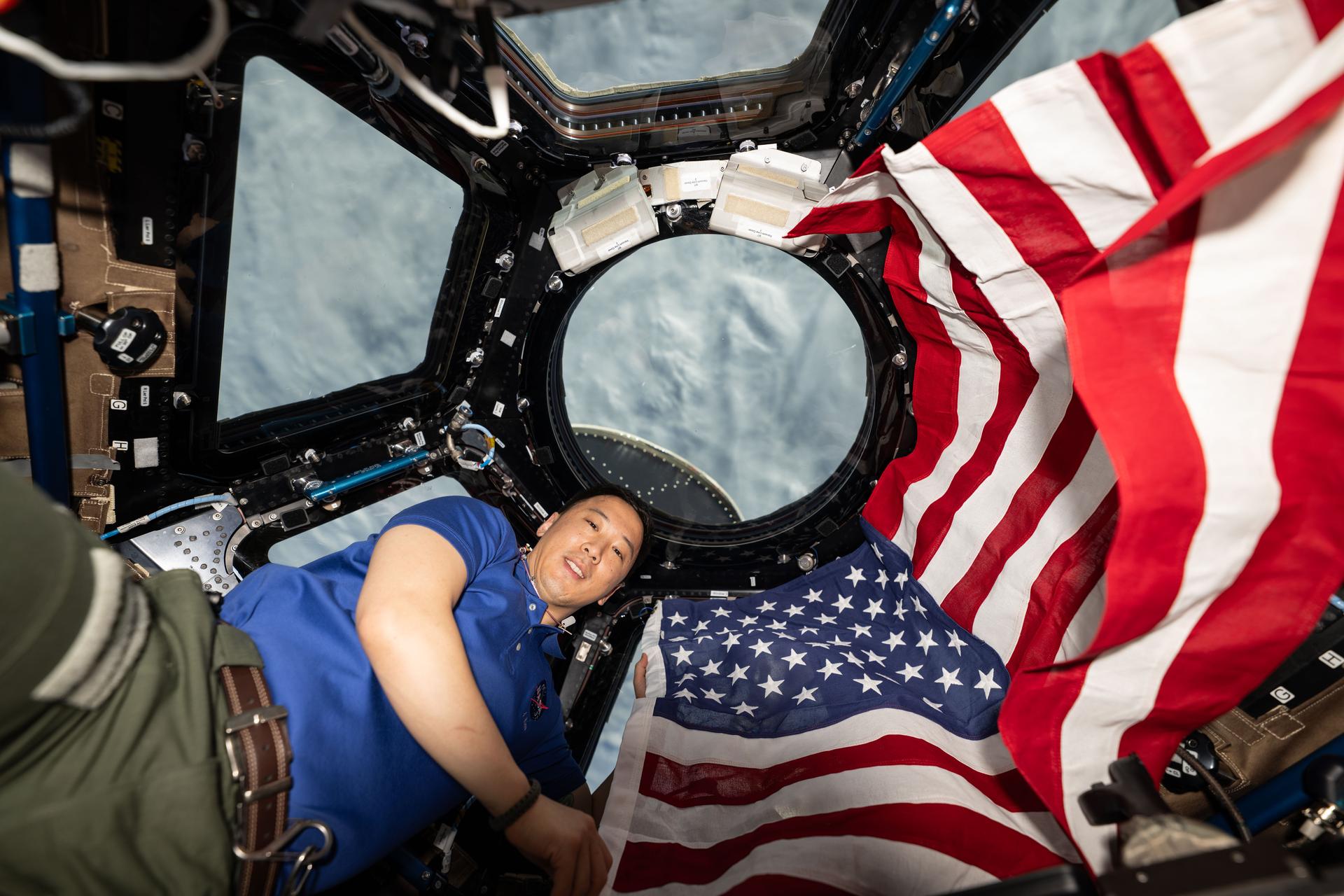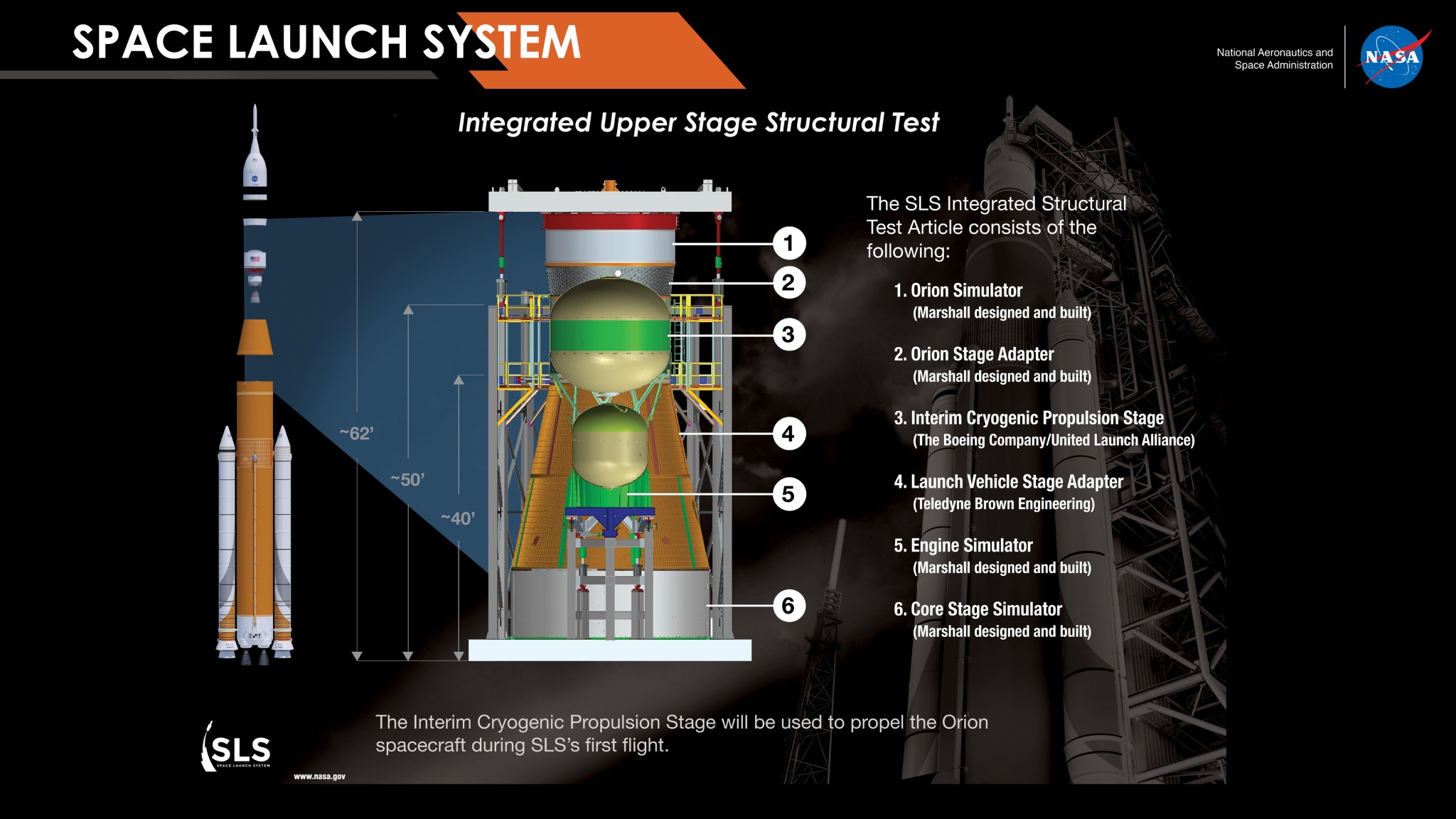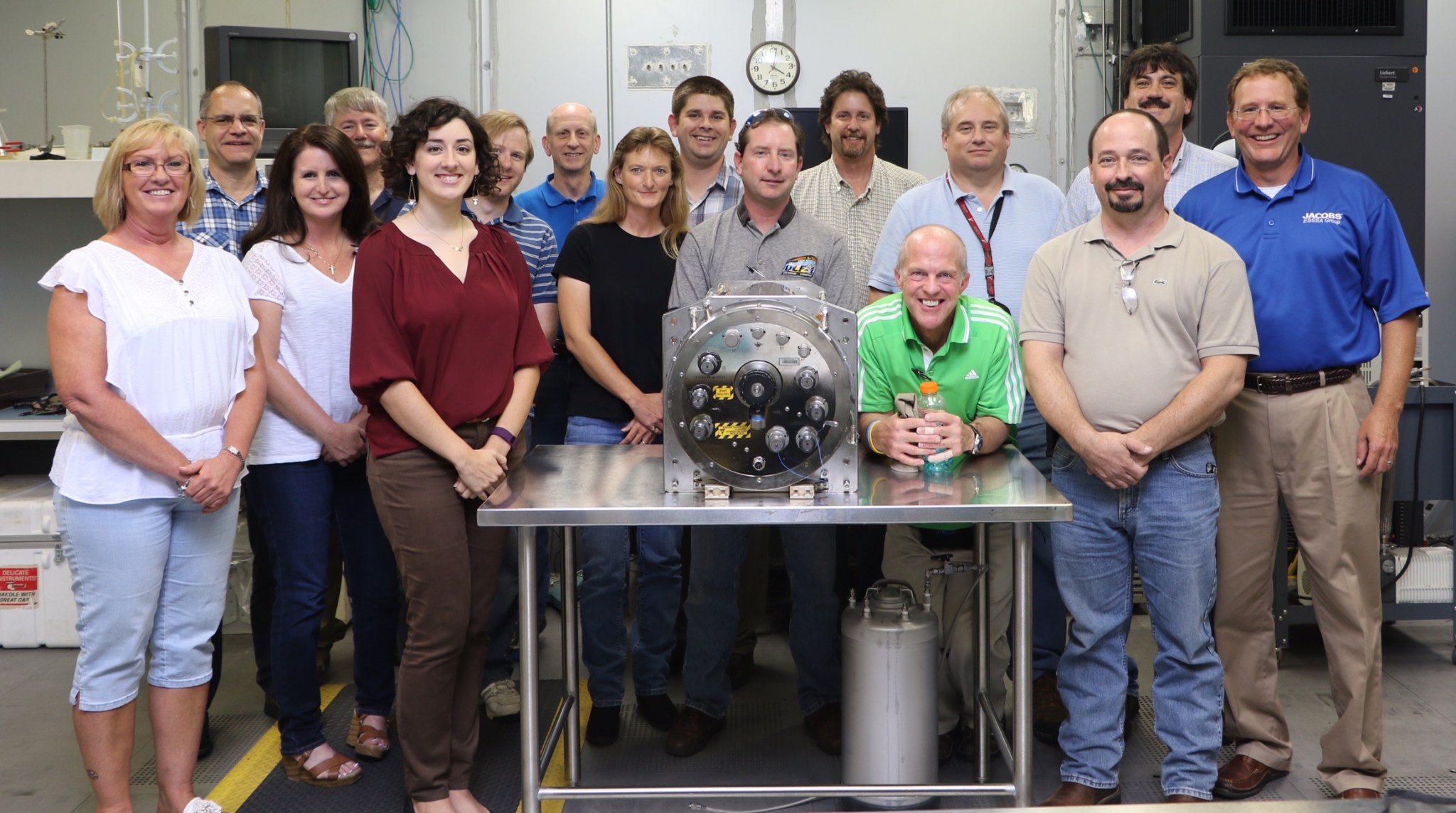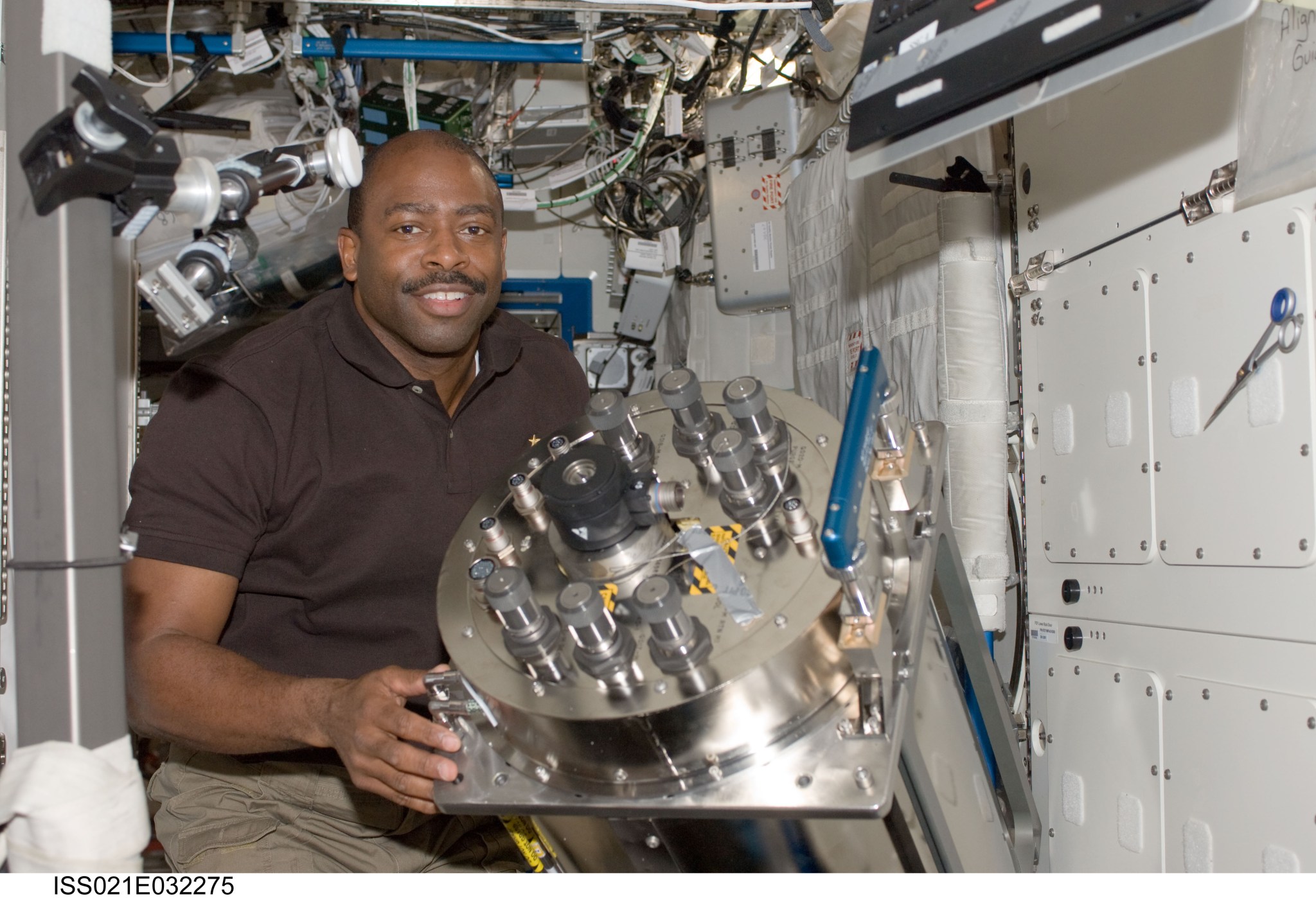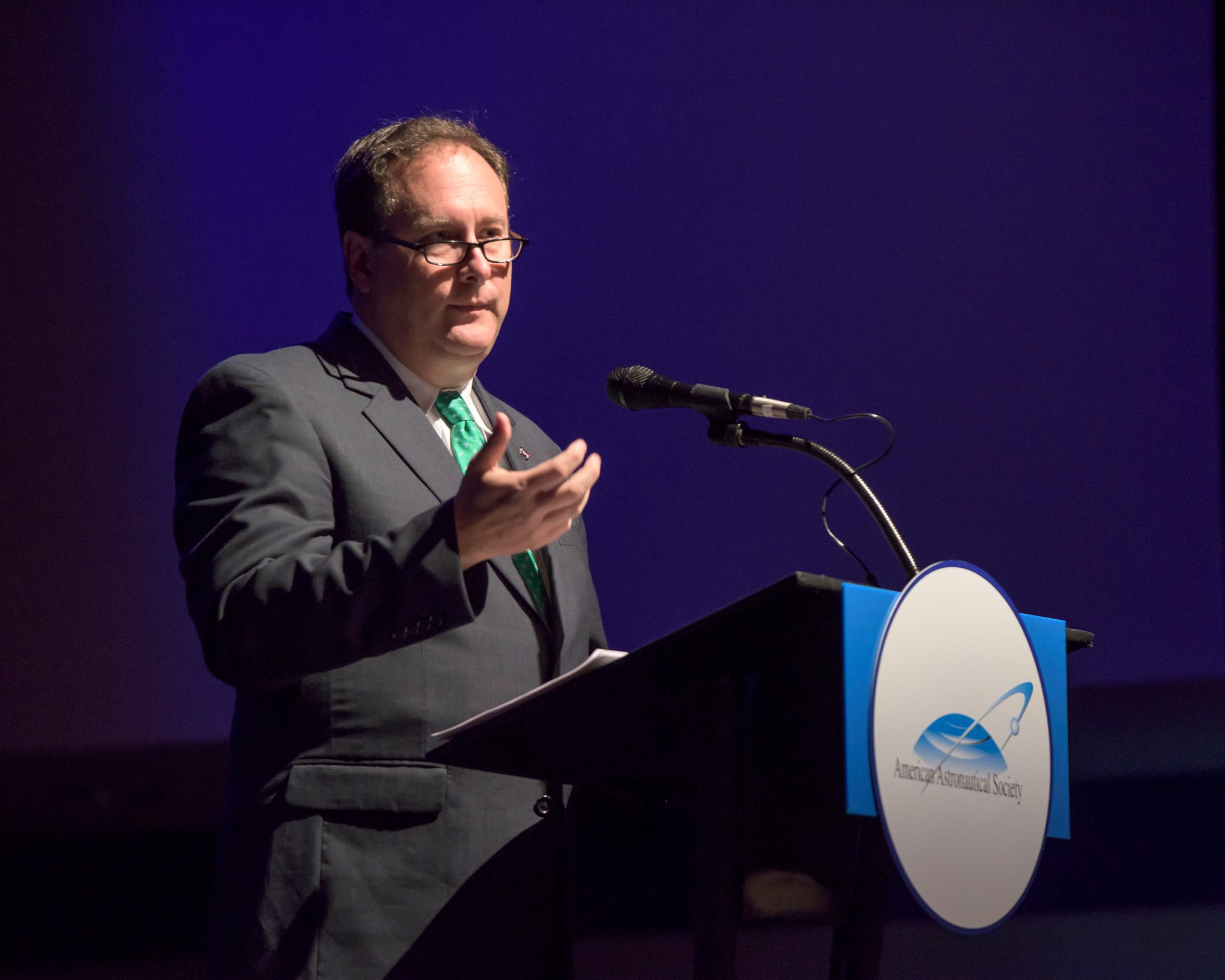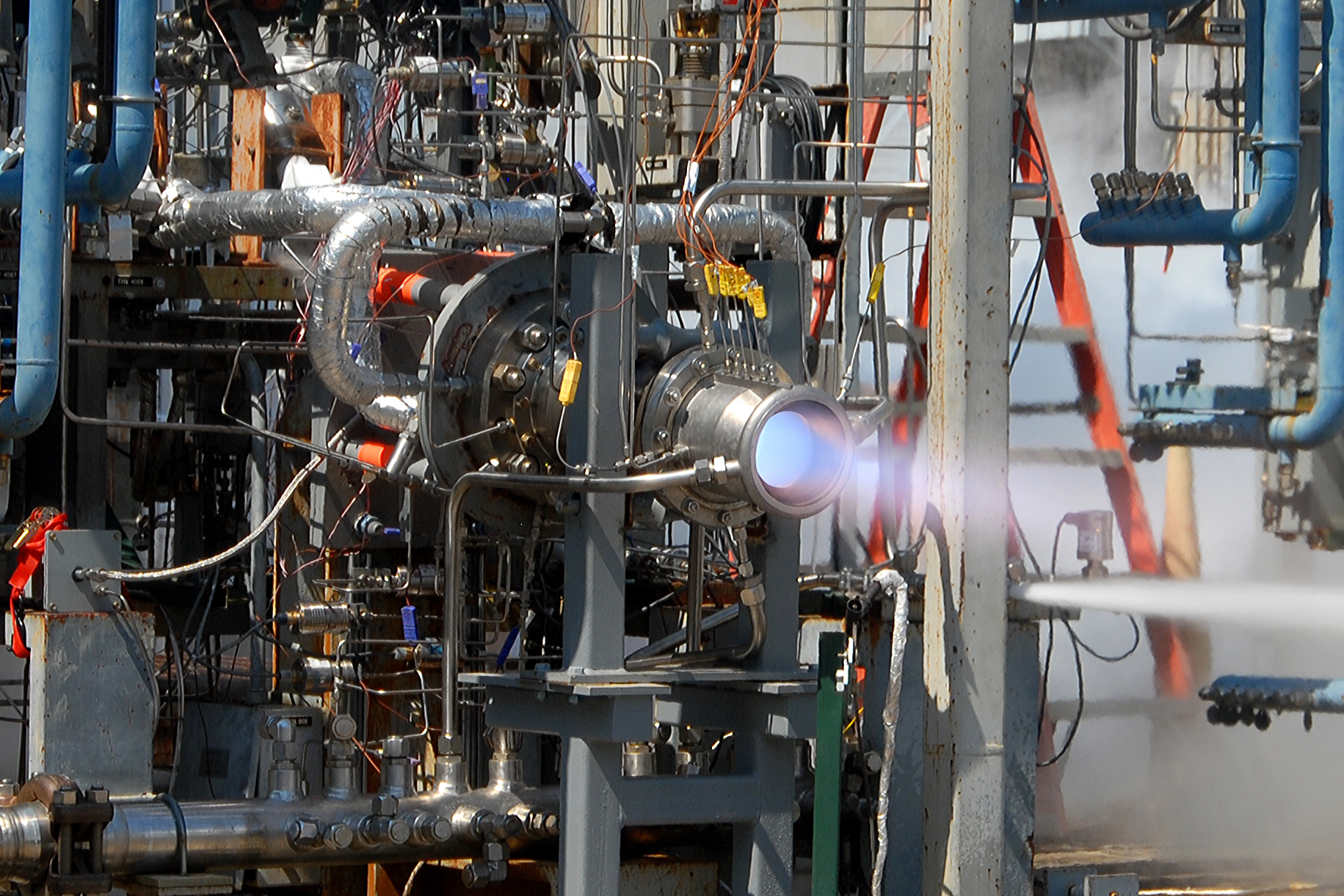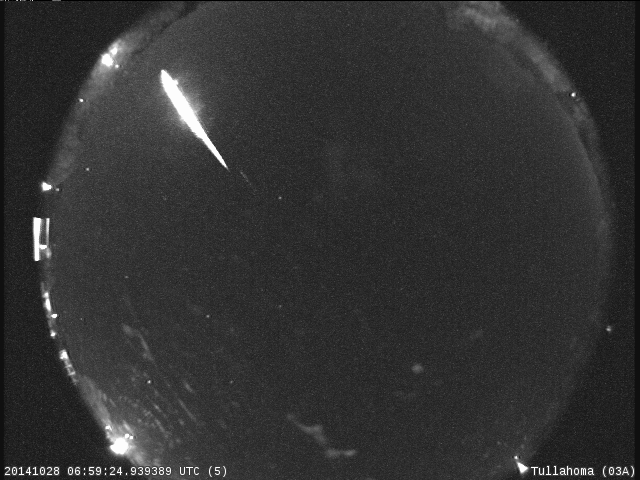In This Week’s Star
- NASA Marks Completion of Test Version of Key SLS Propulsion System
- Marshall-Built Life Support System Outperforms Expectations on International Space Station
- Von Braun Symposium Highlights Space Exploration and Discovery
- NASA Tests Methane-Powered Engine Components for Next Generation Landers
- It’s A Taurid Swarm Year
- Local Leaders Tour ‘Real’ Martian Technology
- Marshall to Host Combined Federal Campaign Mini Charity Fair on Nov. 10
- Marshall Promotes Disability Employment Awareness with Oct. 29 Event
- This Week in NASA History: Marshall and Alabama A&M Sign Cooperative Agreement — November 1968
- Von Braun Symposium Featured on ‘This Week @NASA’
NASA Marks Completion of Test Version of Key SLS Propulsion System
By Megan Davidson
A structural test article of the interim cryogenic propulsion stage for NASA’s new deep-space exploration rocket, the Space Launch System, has been completed at United Launch Alliance in Decatur, Alabama, prior to handover to the Boeing Company of Chicago. Boeing is the prime contractor for the SLS core stage.
The first flight test of the SLS, called Exploration Mission-1, will feature a Block 1 configuration for a 70-metric-ton (77-ton) lift capability and carry an uncrewed Orion spacecraft beyond low-Earth orbit to test the performance of the integrated system. The ICPS is the liquid oxygen/liquid hydrogen-based system that will give Orion the big, in-space push needed on that mission to fly beyond the moon before it returns to Earth.
The ICPS structural test article ultimately will move to NASA’s Marshall Space Flight Center, where it will join other structural test articles and simulators that make up the upper portion of the rocket. Engineers will stack the structural test articles and move the 56-foot-tall structure to a test stand to verify the integrity of the hardware and ensure it can withstand the loads it may experience during flight.
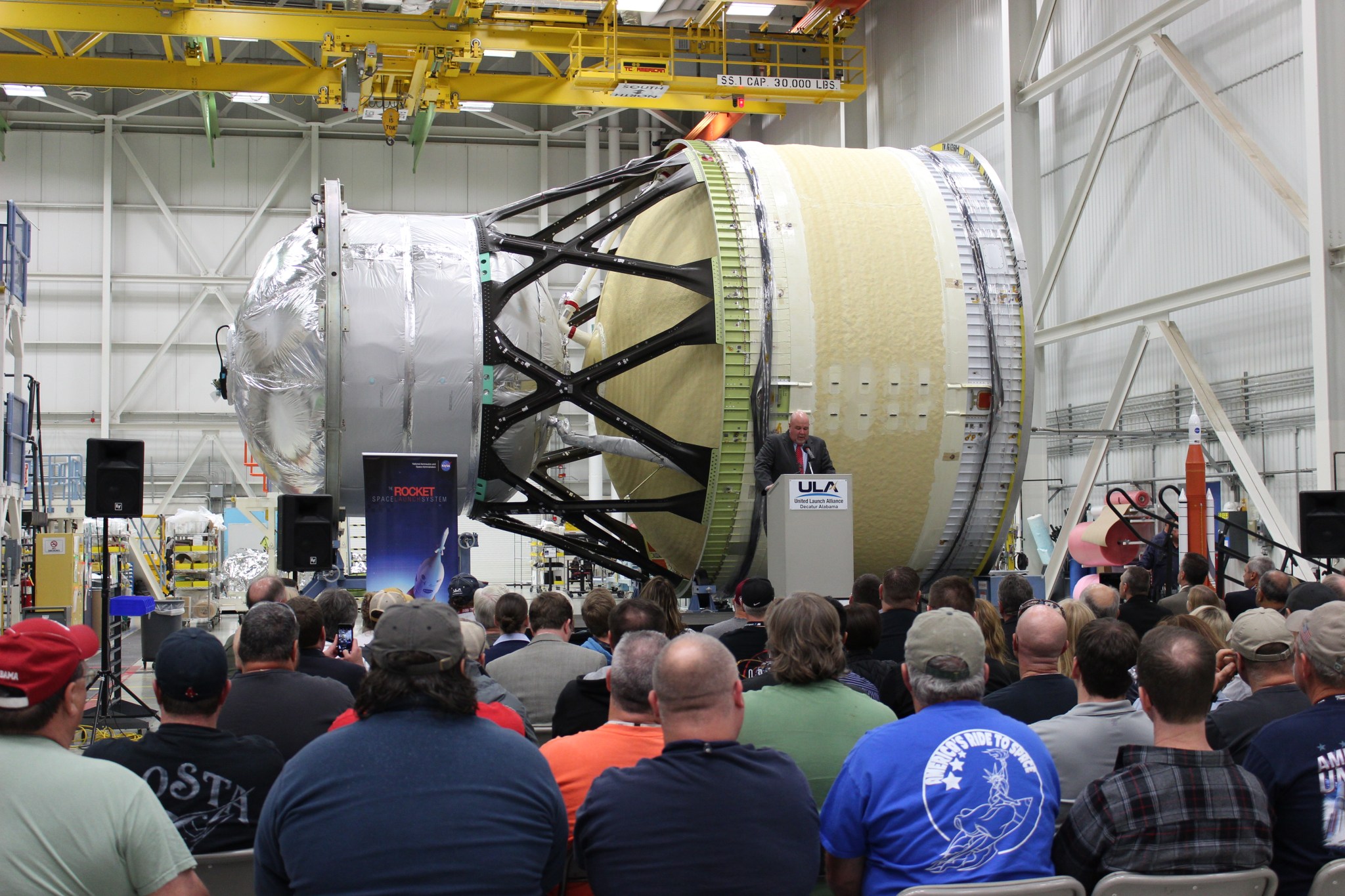
“Not only is the test version of the ICPS complete, but we’ve also started building ICPS hardware for the first flight of SLS,” said Steve Creech, deputy manager of the Spacecraft and Payload Integration & Evolution Office at Marshall, which manages the SLS Program for the agency. “To date, we have fabricated hydrogen tank domes, tank skins and hydrogen tank cylinders. We’re well on our way to being ready for flight.”
In addition to the ICPS, structural test articles have been completed for:
- Orion spacecraft simulator – a replica of the bottom portion of the exploration vehicle that will carry the crew to space, provide emergency abort capability, sustain the crew during space travel, and provide safe re-entry from deep space return velocities.
- Orion stage adapter — connects the Orion to the SLS’s ICPS. The adapter technology was used for Orion’s first test flight in December 2014.
- Core stage simulator — a duplicate of the top of the SLS core stage that is approximately 10 feet tall and 27 feet in diameter. The rocket’s entire core stage will tower more than 200 feet tall and house the vehicle’s avionics and flight computer. It also will store cryogenic liquid hydrogen and liquid oxygen that will feed the vehicle’s RS-25 engines.
A structural test article for the launch vehicle stage adapter, which connects the core stage and the upper stage, is currently in production at Marshall.
“ULA is proud to deliver the test article of the ICPS for NASA’s Space Launch System,” said Gary Wentz, ULA vice president, Human Launch Services. “In partnership with Boeing, ULA created the ICPS through modifications made to our existing Cryogenic Second Stage used on the Delta IV launch vehicle. Congratulations to NASA, Boeing and the entire ULA team for reaching this milestone on schedule.”
Modifications to the Delta Cryogenic Second Stage include lengthening the liquid hydrogen tank, adding hydrazine bottles for attitude control and making some minor avionics changes to meet the design parameters and performance characteristics needed by NASA to meet the flight objectives. An Aerojet Rocketdyne RL-10B2 engine – also currently used on the Delta Cryogenic Second Stage – will power the ICPS.
NASA continues to examine its timeline for evolving SLS toward the Block 1B configuration with a 105-metric-ton (115-ton) lift capability to enable more ambitious missions.
As the SLS evolves, it will ultimately provide an unprecedented lift capability in its Block 2 version capable of lifting 130 metric tons (143 tons) to enable missions even farther into our solar system.
Davidson, an ASRC Federal/Analytical Services employee, supports the Office of Strategic Analysis & Communications.
Marshall-Built Life Support System Outperforms Expectations on International Space Station
By Bill Hubscher
The Space Systems Department at NASA’s Marshall Space Flight Center is celebrating a homecoming of sorts.
A critical part of the Water Recovery System aboard the International Space Station was recently returned to its designers at Marshall after the station crew replaced it with a new part. Before its return to Earth, the part helped provide the station with water by operating successfully for more than 1,000 hours beyond its expected service time — a feat with implications for further human exploration of our solar system.
Marshall engineers and scientists designed and built most of the Environmental Control and Life Support System, or ECLSS, for the station. People living on the orbiting laboratory continuously for the last 15 years are helping NASA learn how to create life support systems for journeys farther into our solar system and could lead to a similar system enabling astronauts to drink water on the surface of Mars.
“Without air or water humans simply cannot travel, live or work in space,” said Walt Schneider, team lead for the Life Support Project for Marshall’s Flight Programs and Partnerships Office, which manages the ECLSS work. “Our team at Marshall is responsible for the design, construction and testing of the regenerative life support hardware, exploring new designs and getting new parts to the station and improving the efficiency of the system that provides clean air and water for crew members.”
Part of that Water Recovery System — the Distillation Assembly, or DA — helps process urine produced by crew members and turns it back into usable water. When versions of the hardware were first installed nearly seven years ago, engineers noticed the DA wasn’t working as well as intended.
“We had some initial issues with calcium deposits,” said Larry Leopard, director of the Space Systems Department at Marshall. “We have since learned astronauts suffer more bone loss than anticipated in a microgravity environment, and a lot of that calcium from bones ends up in their urine. The distillation assembly was having trouble filtering the extra calcium and we had to change machines more frequently than anticipated.”
Since the installation of the ECLSS Urine Processor Assembly in November 2008, more than 22,500 pounds of water have been recycled. If this water were resupplied from Earth, it would have cost more than $225 million to launch and deliver it to the station. The assembly currently recovers 75 percent of wastewater from urine, but that number is expected to climb in 2016. A change in the pre-treatment chemicals will help prevent the calcium-related problems and enable an 85 percent recovery rate.
While the crew was never in any danger and the water recovery system still worked, it was not as efficient as the team would have liked it to be. The calcium deposits meant the amount of water recovered from urine was reduced. A new and improved DA — a cylindrical machine about the size of a kitchen garbage can — was delivered and installed in February 2010.
“It performed exactly as we intended,” said Rex Graves, chief of the Flight Systems Integration and Test Branch at Marshall. “We had an expected life cycle of 4,380 hours. When it reached that, it showed no signs of a decline in performance, so we let it continue doing its job. The assembly finally started showing subtle signs of wear in April 2015 after 5,394 hours of operation, so the crew changed it out with the replacement assembly and the used one was returned to us at Marshall for examination.”
“This has been a challenge from the start,” said Graves. “We pulled together a great team here at Marshall to look at ways to recover water and oxygen on orbit to reduce the need for resupply missions to the space station. Now more than 200 crew members have lived on the station continuously for 15 years and this has taught us not only about the hardware but also about how people living in space affect the life support system’s operations.”
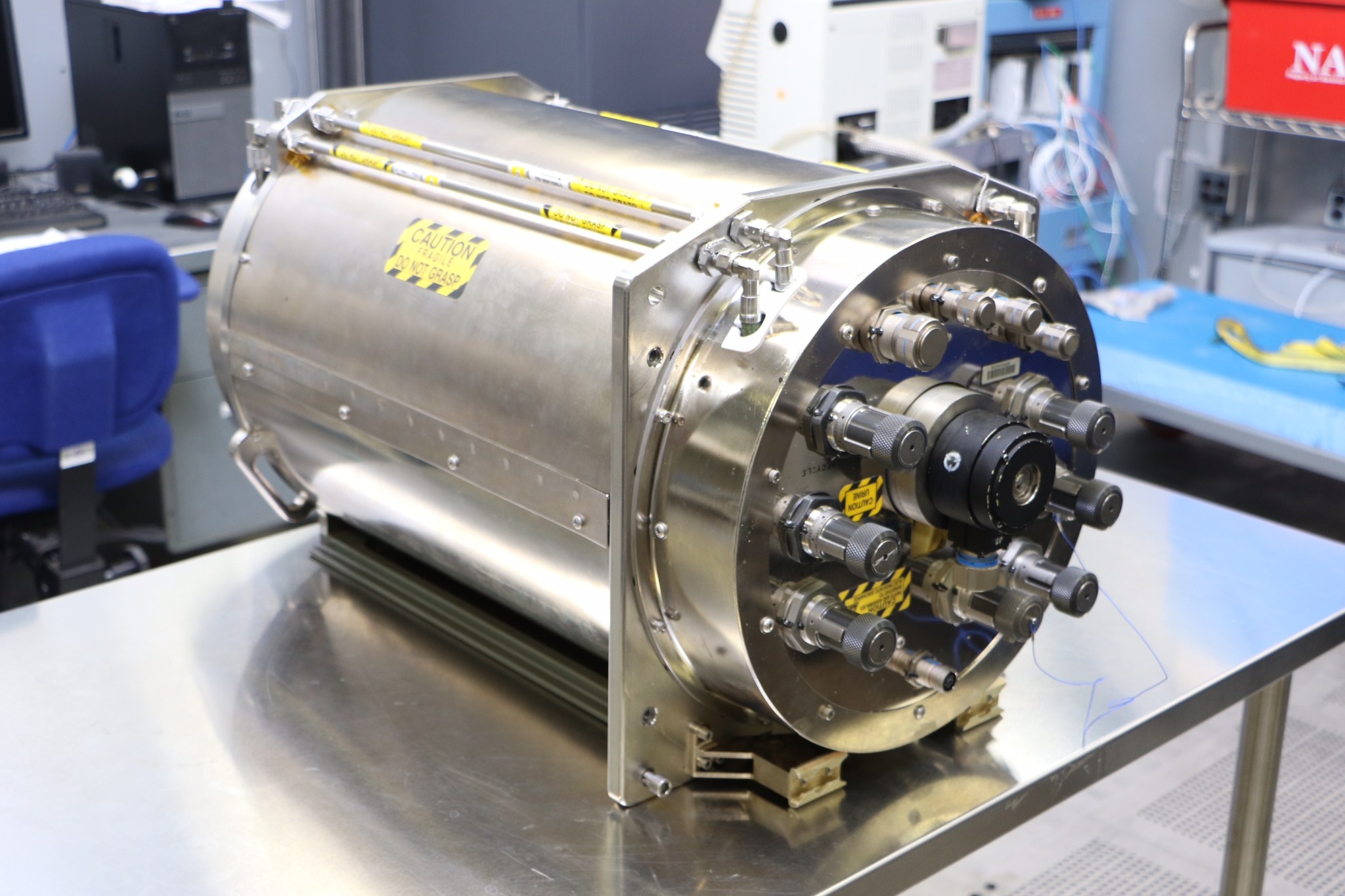
The success of the hardware has a direct effect on NASA’s eventual mission to Mars. The ECLSS team is using information learned from this experience to improve the design and the overall chemical process, creating new hardware that is easier to get into space and uses less electricity.
“Several team members are finishing new designs for other fluid pumps on orbit now,” said Leopard. “We are also looking at concept studies for advanced ECLSS systems that could be smaller and more efficient for the long journey to Mars.”
The space station’s life support system also benefits people on Earth by contributing to water purification systems used around the world.
The ECLSS team is celebrating the homecoming of the assembly by tearing it apart — disassembling it to learn what specific components wore out, what designs can be reused in the next version and maybe get even more time out of the machinery.
Hubscher, an ASRC Federal/Analytical Services employee, supports the Office of Strategic Analysis & Communications.
Von Braun Symposium Highlights Space Exploration and Discovery
By Molly Porter
Aerospace leaders gathered at the University of Alabama in Huntsville Oct. 27-29 for the eighth annual Wernher von Braun Memorial Symposium. The conference, hosted by the American Astronautical Society, provided unique opportunities for attendees to discuss recent developments in space and to build on current and future partnerships.
“The Von Braun Symposium always brings together great minds, and this year is no different,” said Robert Lightfoot, NASA associate administrator, as he addressed attendees during his keynote speech.
The event featured remarks by Lightfoot; Bill Gerstenmaier, NASA associate administrator for Human Exploration and Operations; Steve Jurczyk, NASA associate administrator for Space Technology; and other agency leaders.
This year’s theme, “Space Exploration and Discovery: Expanding Human Knowledge,” provided opportunities for speakers and panelists to discuss NASA’s journey to Mars and the vision of how to get humans there.
“We’re seeing a growing consensus around our plan from policy makers to leaders in the space community, because our plan is sustainable, affordable and clear,” said Lightfoot.
NASA leaders discussed tangible progress on many parts of that plan — including the International Space Station, the Asteroid Redirect Mission, the Space Launch System, the Orion crewed spacecraft and NASA Kennedy Space Center’s revitalized space launch complex.
“The goal is to be Earth-independent by 2029,” said Gerstenmaier.
Achieving Earth-independence means developing and advancing technologies that enable crewed missions lasting two to three years. In deep space, astronauts will need to have everything they need, be able to make it, or have it sent ahead of time.
Collaboration between government, commercial, academic and international partners was a recurring theme throughout the conference.
“None of us can do this alone,” said Todd May, deputy director of NASA’s Marshall Space Flight Center. “A single agency cannot. A single company cannot. Not even a single nation can accomplish such a mission. But united we can.”
Porter is a public affairs officer in the Office of Strategic Analysis & Communications.
NASA Tests Methane-Powered Engine Components for Next Generation Landers
By Brian C. Massey
NASA has tested components for an engine that could be used for Mars landers powered with methane, a fuel that has never before propelled a NASA spacecraft.
A spectacular blue flame erupted as a rocket engine thruster roared to life in a series of tests recently at NASA’s Marshall Space Flight Center. The blue flame, not typical of most engine tests, was the signature of the thruster’s fuel — methane.
“With the current configuration, these methane thrusters could propel a small lander,” said Steve Hanna, lead for NASA’s Advanced Exploration Systems at Marshall. “With the data gained from these tests, the technology is scalable for even larger applications for in-space engines and larger landers.”
A promising fuel for the journey to Mars, methane can be stored at more manageable temperatures, as it is more stable than liquid hydrogen, today’s most common rocket fuel. Methane may be recovered or created from local resources, using in-situ resource utilization.
With a storage temperature similar to that of liquid oxygen — the oxidizer for methane-powered engines — methane’s storage tanks will require less insulation, leading to more affordable tanks. Methane is also denser than liquid hydrogen, which allows for smaller tanks.
With the Mars 2020 mission, NASA plans to will demonstrate in-situ resource utilization technologies that could enable propellant and consumable oxygen production from the Martian atmosphere. If successful, astronauts could create both the fuel and oxidizer needed to propel an ascent vehicle to Martian orbit.
The current thruster being tested, which is part of a pressure-fed design, produces 4,000 pounds of thrust. To achieve the 25,000 pounds of thrust needed for larger descent/ascent landers on Mars, and enable engines to be throttled as needed, Marshall engineers are also developing a pump-fed engine design. In the design, a turbopump will use a turbine capable of up to 95,000 revolutions per minute to deliver methane to the thruster, allowing for higher thrust levels.
Marshall engineers recently successfully conducted preliminary testing and facility checkout of a turbopump for a methane engine. Engineers plan to perform a series of tests later this year to verify the turbopump, previously tested with liquid hydrogen, can be used with either fuel, and is capable of delivering enough fuel to power a large methane engine.
Thrusters — the combination of an injector and chamber, known as thruster assemblies in larger engines — fueled by methane with a liquid oxygen oxidizer, have been under development at Marshall for the last decade. Both the thruster and the turbopump were manufactured with additive manufacturing, or 3-D printing.
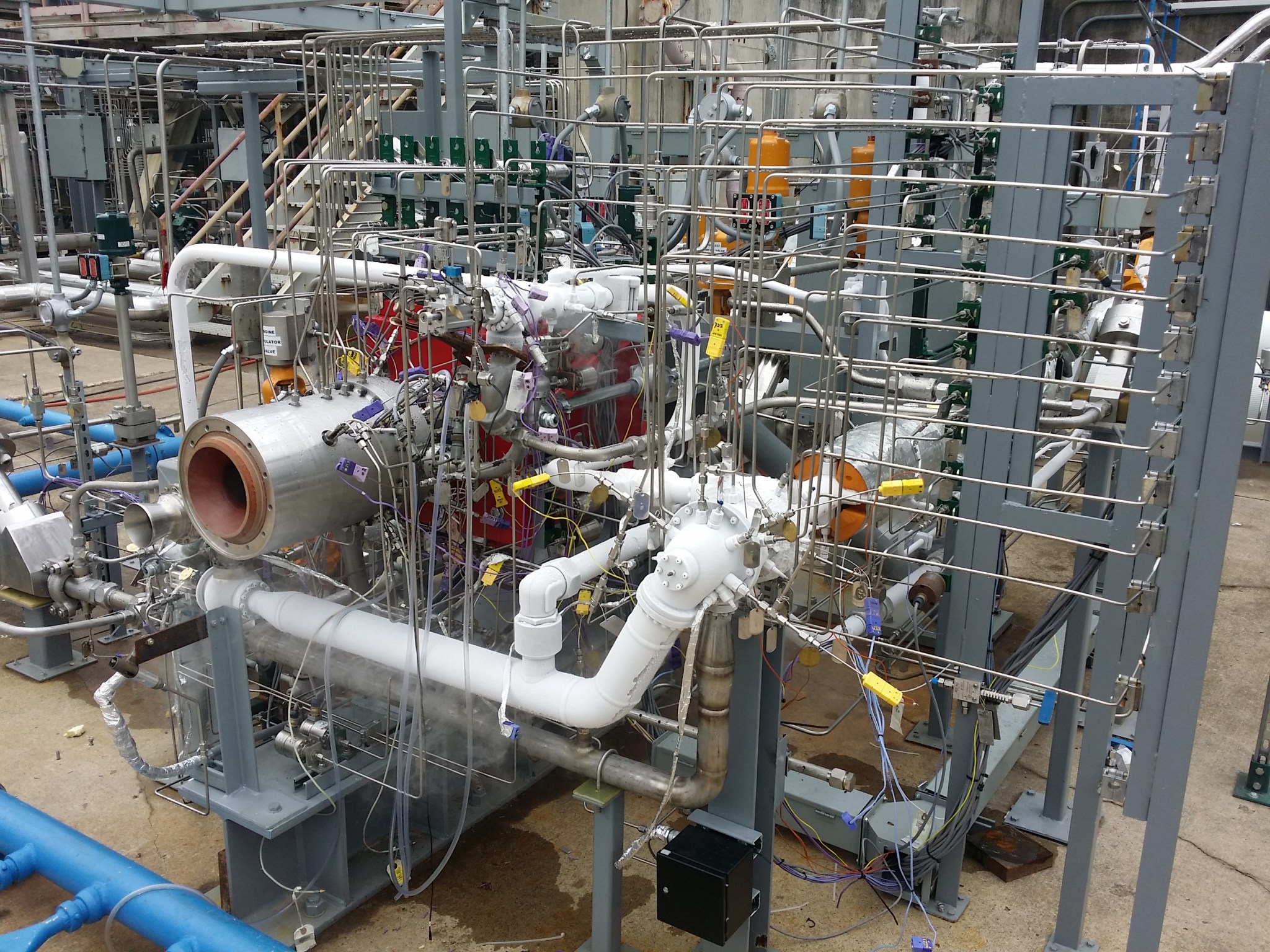
Not only does 3-D printing allow for quicker production times and a reduction in the machining and brazing required with traditional fabrication processes, it also allows for the addition of thermocouple ports along the length of the chamber. These ports communicate with the chamber’s coolant channels, providing discrete temperature data never before available.
“This data will help critical thermal modeling,” said Sandra Greene, an engineer in Marshall’s Propulsion Systems Department. “That’s why the thermocouple ports are so exciting — we not only get the inlet and exit temperature of the methane, but we also get data to help us verify what is happening inside the chamber’s coolant system.”
This unique thermal data will be used to anchor thermal models to optimize the design of the thruster for a full regenerative engine system that uses methane as fuel.
A regenerative engine system cycles fuel through channels within the chamber to cool the chamber before and during ignition. In previous methane thruster development efforts at Marshall, chamber designs were primarily uncooled — using ablative or high-temperature refractory materials to prevent the chamber from overheating.
“To maximize performance, a regeneratively cooled chamber is desired,” said Greene. “This chamber is Marshall’s first attempt at such a design in a methane-powered system.”
With NASA closer to sending astronauts to Mars than ever before, these tests and the technology they inspire could enable the first steps on the Martian surface to come from astronauts exiting a lander driven by a spectacular blue methane flame.
To view video of the methane-powered thruster testing, click here.
Massey, an ASRC Federal/Analytical Services employee and the Marshall Star editor, supports the Office of Strategic Analysis & Communications.
It’s A Taurid Swarm Year
Once a year, Earth passes through a broad stream of debris left by Comet Encke. The dust associated with the comet hits Earth’s atmosphere at 60,000-65,000 mph and burns up, creating the Taurid meteor shower. Most years the shower is weak, and only a few Taurid meteors can be seen each night. Other years, the Taurids can put on a show.
According to some scientists, this year the Taurids may be more active than usual and feature spectacular fireballs. Enhancements like this occur every few years and are known as Taurid “swarms,” as Jupiter’s gravity concentrates a group of pebble-sized fragments from the comet near Earth’s path, which then burn up in Earth’s atmosphere, creating bright fireballs. Given the behavior of past Taurid swarms, increased fireball activity may be seen during the last week of October and the first two weeks of November.
“The annual Taurid meteor shower is going on right now, and we are seeing steady activity in our meteor cameras,” said Bill Cooke, lead for the NASA Meteoroid Environments Office at NASA’s Marshall Space Flight Center. “Individuals should not be surprised if they see a bright meteor or fireball over the next few nights.”
During the swarm, Taurid meteors can be seen any time the constellation Taurus is above the horizon. The best time to look for Taurids is after midnight, when Taurus is high in the sky, the sky is dark and clear and there is no moonlight to mask fainter meteors.
For more information, visit the NASA Watch the Skies Blog.
Local Leaders Tour ‘Real’ Martian Technology
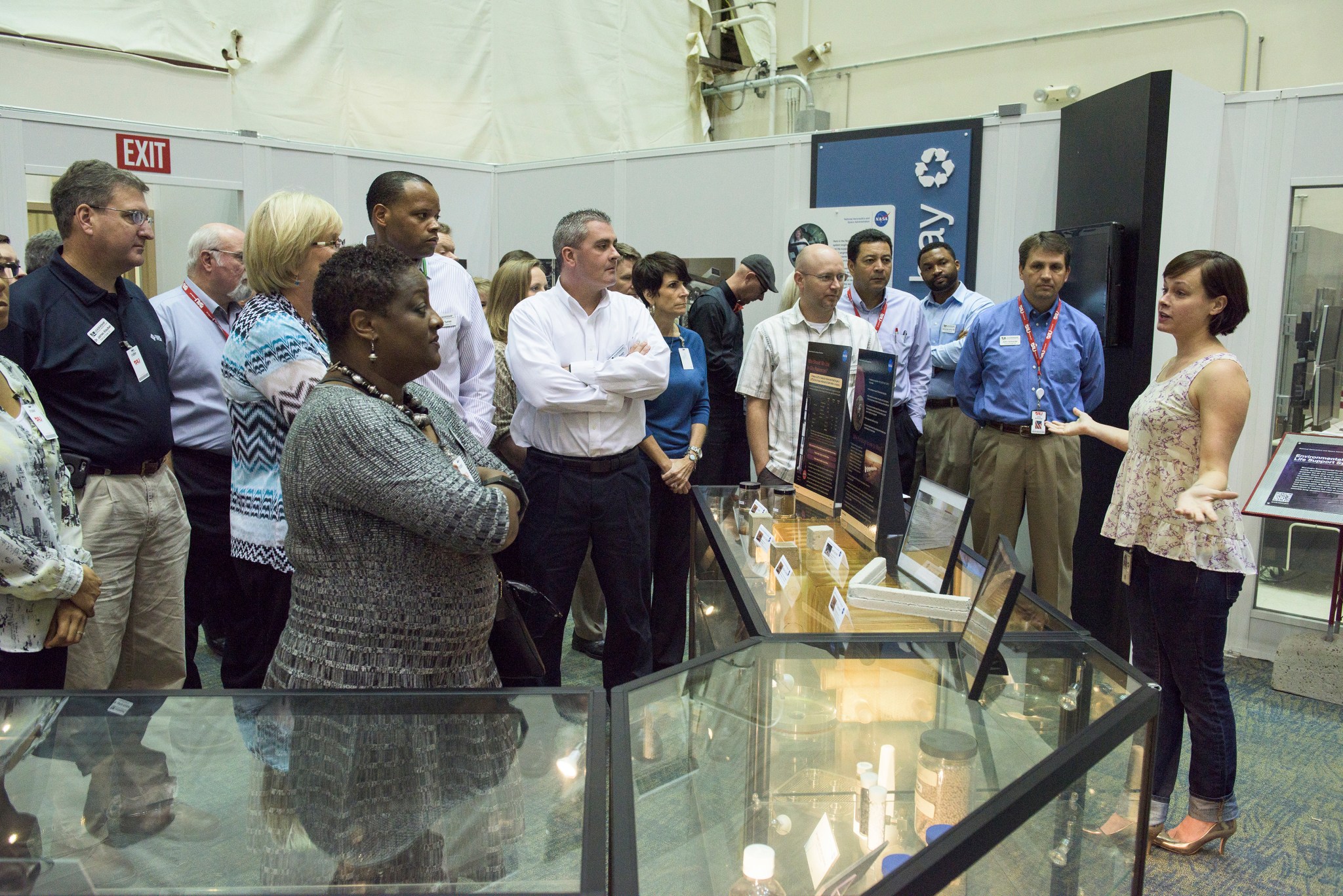
NASA Marshall Space Flight Center engineer Mallory Johnston, right, shows members of the Leadership Huntsville/Madison County Focus group, during a tour Oct. 23, how work at Marshall is helping develop the capabilities needed to send humans to an asteroid and ultimately Mars. The tour highlighted Marshall’s contributions to NASA’s journey to Mars, including advancing environmental control and life support system technologies to enable deep-space, long-duration missions. (NASA/MSFC/Fred Deaton)
Marshall to Host Combined Federal Campaign Mini Charity Fair on Nov. 10
On Nov. 10, NASA’s Marshall Space Flight Center will host a Combined Federal Campaign mini charity fair from 10:30 a.m. to 1:30 p.m. in Building 4203. All Marshall team members are invited to stop by and talk with representatives from 10 local nonprofit organizations, agencies and institutions whose focus includes serving veterans, and learn about their work and beneficiaries.
Participating charities include Nexus Energy, Operation Stand Down-Huntsville, The BentProp Project, Alliance for Opportunity and Development, CASA of Madison County, American Cancer Society, Still Serving Veterans, New Hope Children’s Clinic, Alabama A&M University and The Greater Huntsville Humane Society.
Laptop computers will be available during the event for team members to make on-the-spot pledges using a NASA PIV Smartcard and PIN or an Employee Express user name and password.
This mini charity fair is the second in a series of three to be hosted by the 2015 CFC Committee. Each event will have a theme focusing on the type of service provided by the specific charities that are represented. The final charity fair is scheduled Dec. 3.
For more information about CFC mini fairs, please contact Rhoney Triplett.
Marshall Promotes Disability Employment Awareness with Oct. 29 Event
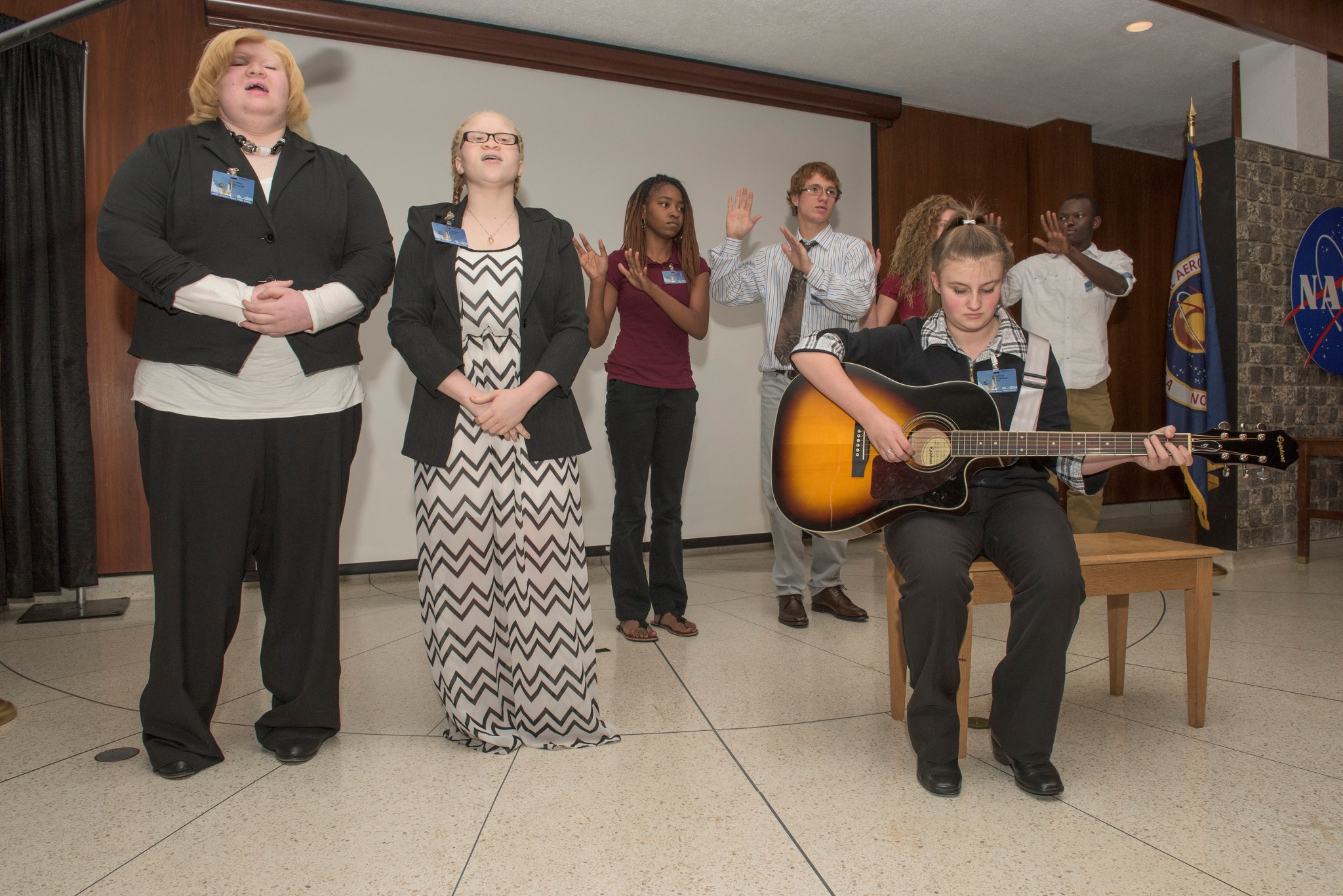
On Oct. 29, NASA’s Marshall Space Flight Center celebrated the contributions of workers with disabilities while also educating team members about disability employment issues. Here, students from the Alabama Institute for the Deaf and Blind in Talladega, Alabama, perform the national anthem to begin the event. Richie Parker, an engineer for NASCAR’s Hendricks Motorsports, also spoke and vendors displayed the latest technology for those working with disabilities. The event — sponsored by the Office of Diversity and Equal Opportunity — was part of national Disability Awareness Month. (NASA/MSFC/Fred Deaton)
This Week in NASA History: Marshall and Alabama A&M Sign Cooperative Agreement — November 1968
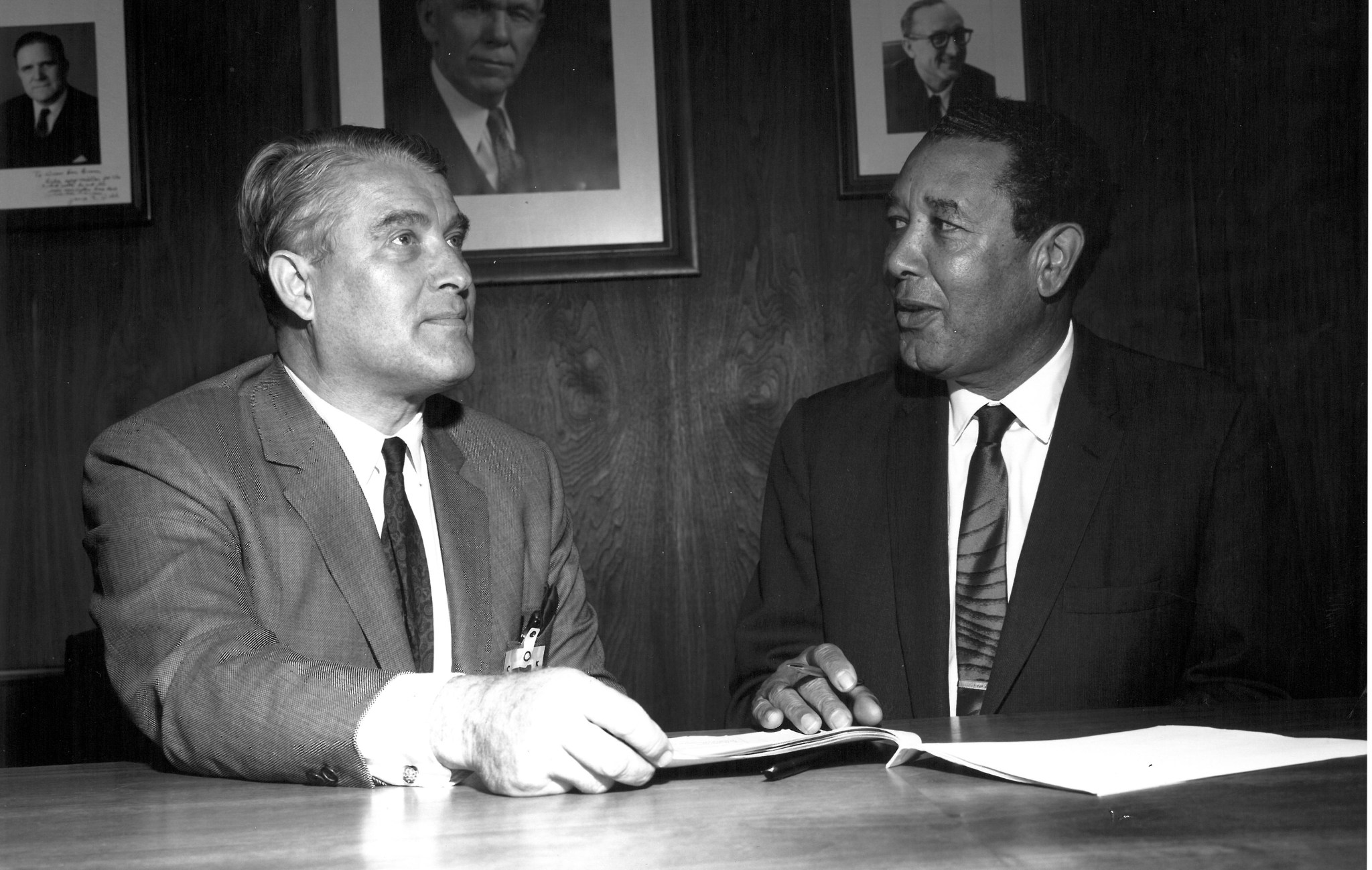
This week in 1968, NASA Marshall Space Flight Center Director Wernher von Braun, left, and Alabama A&M University President Richard Morrison signed a cooperative agreement. Marshall has a long-held a commitment to ensure that historically black colleges and universities, like Alabama A&M, play an active role in NASA’s research programs and overall mission. The NASA History Program documents and preserves NASA’s remarkable history through a variety of products — photos, press kits, press releases, mission transcripts and administrators’ speeches. For more pictures like this one and to connect to NASA’s history, visit the History Program’s Web page.
Von Braun Symposium Featured on ‘This Week @NASA’
The Wernher von Braun Symposium is featured in the latest edition of “This Week @NASA,” a weekly video program broadcast nationwide on NASA-TV and posted online.
The 8th annual Wernher von Braun Memorial Symposium was held at the University of Alabama in Huntsville Oct. 28-29. The event featured remarks by NASA Associate Administrator Robert Lightfoot; Associate Administrator for Human Exploration and Operations Bill Gerstenmaier; Associate Administrator for Space Technology Steve Jurczyk; and other agency leaders. This year’s symposium focused on benefits, challenges and opportunities in advancing space activities, and recent progress in science, engineering and technology.
View this and previous episodes at “This Week @NASA” or at https://www.youtube.com/user/NASAtelevision.

